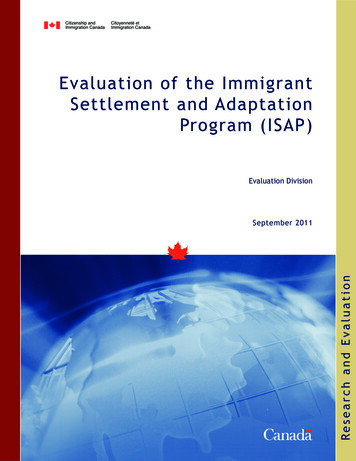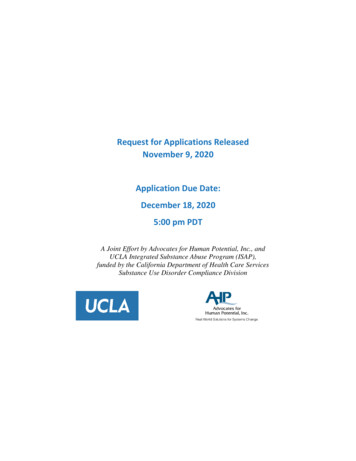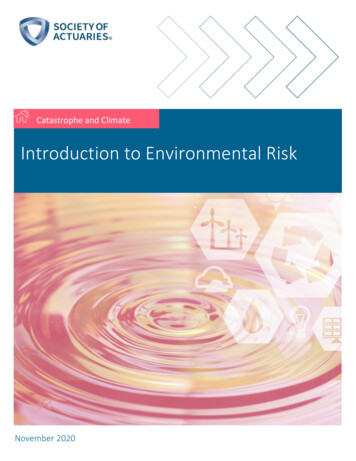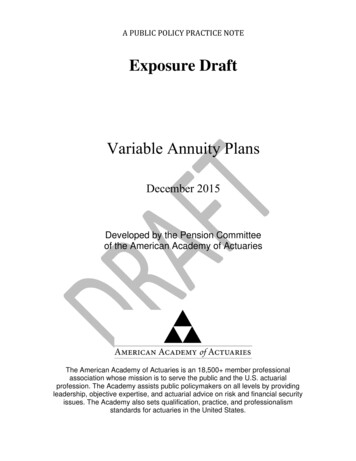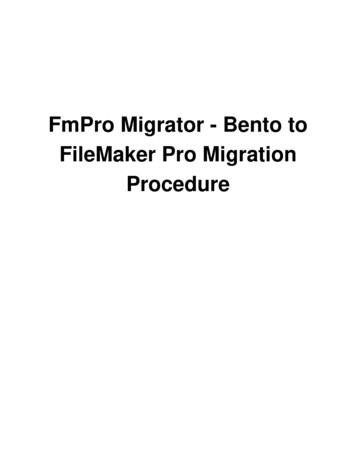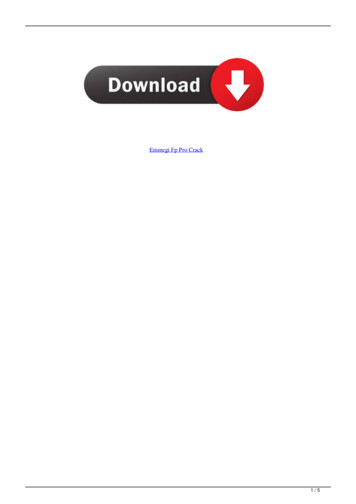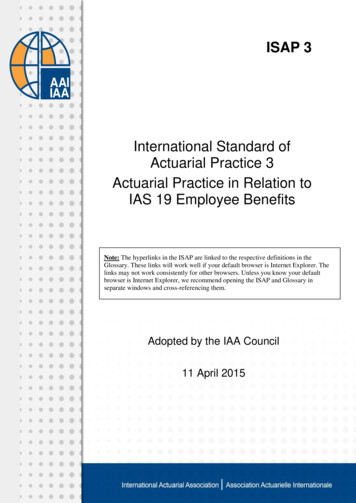
Transcription
ISAP 3(ProInternational Standard ofActuarial Practice 3Actuarial Practice in Relation toIAS 19 Employee BenefitsNote: The hyperlinks in the ISAP are linked to the respective definitions in theGlossary. These links will work well if your default browser is Internet Explorer. Thelinks may not work consistently for other browsers. Unless you know your defaultbrowser is Internet Explorer, we recommend opening the ISAP and Glossary inseparate windows and cross-referencing them.Adopted by the IAA Council11 April 2015
TABLE OF CONTENTSPreface . iiIntroduction . ivSection 1. General . 11.1Purpose . 11.2Scope . 11.3Compliance . 11.4Relationship to ISAP 1 . 11.5Defined Terms . 11.6Cross References . 11.7Effective Date . 2Section 2. Appropriate Practices . 32.1Knowledge of Accounting Requirements . 32.2Materiality . 32.3Proportionality. 32.4Constructive Obligations . 42.5Categorization of Employee Benefit Plan . 42.6Actuarial Assumptions . 42.7Plan Assets . 92.8Asset Ceiling . 92.9Attribution of Benefits to Service Periods . 9Section 3. Communication . 103.1Disclosures in the Report . 10Appendix . 11i
PrefaceThis International Standard of Actuarial Practice (ISAP) is a model for actuarial standardsetting bodies to consider.The International Actuarial Association (IAA) encourages relevant actuarial standard-setting bodiesto maintain a standard or set of standards that is substantially consistent with this ISAP to the extentthat the content of this ISAP is appropriate for actuaries in their jurisdiction. This can be achieved inmany ways, including: Adopting this ISAP as a standard with only the modifications in the Drafting Notes; Customizing this ISAP by revising the text of the ISAP to the extent deemedappropriate by the standard-setting body while ensuring that the resulting standard or setof standards is substantially consistent with this ISAP; Endorsing this ISAP by declaring that this ISAP is appropriate for use in certain clearlydefined circumstances; Modifying existing standards to obtain substantial consistency with this ISAP; or Confirming that existing standards are already substantially consistent with this ISAP.A standard or set of standards that is promulgated by a standard-setting body is considered to besubstantially consistent with this ISAP if: There are no material gaps in the standard(s) in respect of the principles set out in thisISAP; and The standard or set of standards does not contradict this ISAP.If an actuarial standard-setting body wishes to adopt or endorse this ISAP, it is essential to ensurethat existing standards are substantially consistent with ISAP 1 as this ISAP relies upon ISAP 1 inmany respects. Likewise, any customization of this ISAP, or modification of existing standards toobtain substantial consistency with this ISAP, should recognize the important fact that this ISAPrelies upon ISAP 1 in many respects.If this ISAP is translated for the purposes of adoption, the adopting body should select three verbsthat embody the concepts of “must”, “should”, and “may”, as described in paragraph 1.6. Languageof ISAP 1, even if such verbs are not the literal translation of “must”, “should”, and “may”.This ISAP is binding upon an actuary only if so directed by the actuary’s standard-settingbody or if the actuary states that some or all of the work has been performed in compliancewith this ISAP (e.g., if the actuary is directed by the principal to comply with this ISAP).This ISAP was adopted by the IAA Council in April 2015.[Drafting Notes: when an actuarial standard-setting organization adopts this standard it should:1.Replace “ISAP” throughout the document with the local standard name, if applicable;2.Modify references to ISAP 1 in paragraphs 1.3, 1.4, 2.1, 2.2.2, 2.3, 2.4, 2.5.3, 2.6, 2.6.3,2.7.1, and 3.1 to point to the local standard(s) that are substantially consistent with ISAP1, rather than referring to ISAP 1 directly, if appropriate;3.Choose the appropriate phrase and date in paragraph 1.7;4.Review this standard for, and resolve, any conflicts with the local law and code ofprofessional conduct; andii
5.Delete this preface (including these drafting notes) and the footnote associated withparagraph 1.7.]iii
ISAP 3 IAS 19 Employee BenefitsApril 2015IntroductionThis International Standard of Actuarial Practice (ISAP) provides guidance to actuaries whenperforming actuarial services in connection with International Accounting Standard 19 (IAS 19)Employee Benefits.The reporting entity is responsible for all the information reported in its IFRS financial statements,including information reported in accordance with IAS 19. This means the reporting entity isresponsible for the categorization of employee benefit plans, the choice of actuarial assumptionsand methods used to measure employee benefit obligations, and disclosures about employee benefitplans. IAS 19 encourages, but does not require, a reporting entity to involve a qualified actuary inthe measurement of all material post-employment benefit obligations.In practice, an actuary may advise on a range of issues arising from the application of IAS 19,including the measurement of short-term, post-employment, termination, or other long-termemployee benefits and disclosures in the IFRS financial statements.This ISAP is intended to: Facilitate convergence in standards of actuarial practice in connection with IAS 19within and across jurisdictions; Increase reporting entities’ and their auditors’ confidence in actuaries’ contributions toreporting of employee benefits in accordance with IAS 19; Increase public confidence in actuaries’ services for IAS 19 purposes; and Demonstrate the IAA’s commitment to support the work of the InternationalAccounting Standards Board (IASB) in achieving high-quality, transparent, andcomparable financial reporting internationally, as envisaged by the Memorandum ofUnderstanding between the IAA and the IASB.iv
ISAP 3 IAS 19 Employee BenefitsApril 2015Section 1. General1.1. Purpose – This ISAP provides guidance to actuaries when performing actuarial services inconnection with IAS 19. Its purpose is to increase intended users’ confidence that: Actuarial services are carried out professionally and with due care, consistently withIAS 19, and taking into account the reporting entity’s accounting policies; The results are relevant to their needs, are presented clearly and understandably, and arecomplete; and The assumptions and methodology (including, but not limited to, models and modellingtechniques) used are disclosed appropriately in the actuary’s report.1.2. Scope – This ISAP provides guidance to actuaries when providing actuarial services for areporting entity’s preparation of an actual or pro-forma IFRS financial statement for any typeof employee benefit the reporting entity determines to be covered by IAS 19. Actuariesproviding actuarial services in connection with IAS 19 that are outside of this scope (forexample, an actuary advising an auditor or advising a potential buyer regarding anacquisition) should consider the guidance in this ISAP to the extent relevant to theassignment.1.3. Compliance – [For this ISAP, this paragraph replaces paragraph 1.3. in ISAP 1] An actuarymay fail to follow the guidance of this ISAP but still comply with it where the actuary:1.3.1.Complies with requirements of law that conflict with this ISAP;1.3.2.Complies with requirements of the actuarial code of professional conduct applicableto the work that conflict with this ISAP; or1.3.3.Departs from the guidance in this ISAP and provides, in any report, an appropriatestatement with respect to the nature, rationale, and effect of any such departure.1.4. Relationship to ISAP 1 – Where possible, this ISAP does not repeat guidance alreadyprovided in ISAP 1. Any actuary who asserts compliance with this ISAP (as a modelstandard) must also comply with ISAP 1. References in ISAP 1 to “this ISAP” should beinterpreted as applying equally to this ISAP 3, where appropriate.1.5. Defined Terms – This ISAP uses various terms whose specific meanings are defined in theGlossary. These terms are highlighted in the text with a dashed underscore and in blue, whichis a hyperlink to the definition (e.g., actuary). This ISAP also uses terms defined in IAS 19, inwhich case they have the same meaning.1.6. Cross References – This ISAP refers to the content of IAS 19, including any interpretationsfrom the International Financial Reporting Interpretations Committee or the StandingInterpretations Committee thereon, as issued through September 2014. If IAS 19 issubsequently amended, restated, revoked, or replaced after September 2014, the actuaryshould consider the guidance in this ISAP to the extent it remains relevant and appropriate.1
ISAP 3 IAS 19 Employee BenefitsApril 20151.7. Effective Date – This ISAP is effective for {actuarial services performed/actuarial servicescommenced/actuarial services performed with respect to an IFRS financial statement for areporting period ending}1 on or after [Date].1[Phrase to be selected and date to be inserted by standard-setter adopting or endorsing thisISAP.].2
ISAP 3 IAS 19 Employee BenefitsApril 2015Section 2. Appropriate Practices2.1. Knowledge of Accounting Requirements –The actuary should have or obtain sufficientknowledge and understanding of IAS 19, IFRSs that are interpretations of IAS 19, relevantparagraphs of other IFRSs to which IAS 19 specifically refers, and the reporting entity’srelevant accounting policies, if any. If the actuary:a.Is uncertain whether another IFRS is relevant to the actuarial services; orb.Discovers that a specific component of the actuarial services may be subject toalternative interpretations of IAS 19, an IFRS that is an interpretation of IAS 19, arelevant paragraph of another IFRS to which IAS 19 specifically refers, or relevantaccounting policies,the actuary should seek guidance from the principal, and treat the guidance as information towhich ISAP 1, paragraph 2.3. Reliance on Others, applies.2.2. Materiality – The actuary should understand the distinction between materiality with respectto the actuarial services, the preparation of IFRS financial statements, and the auditing ofthose financial statements.2.2.1.When appropriate for the work, the actuary should seek guidance from the principalor reporting entity regarding materiality with respect to the preparation of IFRSfinancial statements and take that guidance into account when performing theactuarial services.2.2.2.In applying ISAP 1 paragraph 2.4. Materiality, the actuary’s threshold of materialitywith respect to the actuarial services should not be greater than the reporting entity’sthreshold of materiality with respect to the preparation of IFRS financial statements,if it is known. The principal or reporting entity (not the user of the IFRS financialstatements) is the intended user of the actuarial services when assessing materialitywith respect to the actuarial services.2.2.3.In all following paragraphs of this ISAP, any use of “material”, “materially”, or“materiality” is with respect to the actuarial services.2.3. Proportionality – In applying ISAP 1 paragraph 1.5. Reasonable judgment, and in particularparagraph 1.5.2., the actuary should take materiality into account. The degree of refinement inspecific assumptions or methods recommended by the actuary should be consistent with theimpact on the actuarial services. Examples include, all of which are subject to the actuary’sprofessional judgment:a.The actuary may use simplified approaches to recommending assumptions when thoseassumptions will not materially affect the results or are proportionate for the actuarialservices. For example, when a pension plan pays primarily lump sum benefits attermination or retirement, the choice of mortality assumption may have little impact onthe liabilities. As a second example, for certain work-related accident or injury benefits,the projected benefit cash flows may be so uncertain as to make a highly refinedapproach to selecting the discount rate disproportionate.b.In lieu of collecting new employee census data at the measurement date, the actuarymay appropriately adjust results using data collected at a different date when doing sowill not materially affect the results.c.The actuary may apply or amend assumptions selected for other purposes (such as todetermine funding of the employee benefit plan) or demographic assumptions used at a3
ISAP 3 IAS 19 Employee BenefitsApril 2015prior measurement date when those assumptions are reasonable for IAS 19 purposes atthe current measurement date.d.The actuary may apply simplified methods to attribute benefits to periods of servicewhen doing so will not materially affect the results.2.4. Constructive Obligations – The actuary may rely on representations made by the principalregarding the existence and nature of any constructive obligations arising from the reportingentity’s employee benefit practices or policies. When doing so, the actuary should be guidedby ISAP 1 paragraph 2.3. Reliance on Others.If it becomes apparent to the actuary in the course of performing the actuarial services thatsignificant uncertainties exist regarding such representations, the actuary should seekclarification from the principal. If the uncertainty is not resolved to the actuary’s satisfaction,the actuary should be guided by ISAP 1 paragraph 2.5.4. Data Deficiencies.This guidance does not impose additional duties on the actuary beyond the scope of theactuarial services to search for or analyze constructive obligations that go beyond formal plansor agreements.2.5. Categorization of Employee Benefit Plan – The reporting entity is responsible fordetermining the categorization of its employee benefit plans under IAS 19 as short-term,defined benefit post-employment, defined contribution post-employment, termination, orother long-term.2.5.1.The actuary may advise the principal regarding the categorization of an employeebenefit plan. When providing such advice, the actuary should exercise professionaljudgment when an employee benefit plan has characteristics of multiple categories(such as retirement plans that combine elements of defined benefit and definedcontribution plans, or employment-related injury benefits that include both medicalcare and wage replacement).2.5.2.If the actuary is uncertain as to the reporting entity’s categorization of an employeebenefit plan, the actuary should seek guidance from the principal.2.5.3.The actuary should treat the reporting entity’s categorization of its employee benefitplans as a prescribed methodology to which ISAP 1 paragraph 2.8. Assumptions andMethodology Prescribed applies.2.6. Actuarial Assumptions – The reporting entity is responsible for selecting assumptions thatare unbiased, mutually compatible, and represent the reporting entity’s best estimates of thevariables that will determine the ultimate costs of its employee benefits. The actuary mayadvise the principal regarding the selection or reasonableness of some or all of theassumptions to be used in the actuarial services. In doing so, the actuary should be guided byparagraphs 2.6. to 2.9. of ISAP 1, taking into account IAS 19’s requirements regardingassumptions used to measure defined benefit post-employment plans, termination benefits, orother long-term benefits. In particular, when using prescribed assumptions, the actuary shouldbe guided by ISAP 1 paragraph 2.8. Assumptions and Methodology Prescribed.2.6.1.General Approach for Selecting Assumptions – When advising the principal on theselection or reasonableness of actuarial assumptions, the actuary should:a.Identify the types of assumptions needed to perform the actuarial services.b.Evaluate information relevant to each type of assumption:4
ISAP 3 IAS 19 Employee Benefitsi.April 2015With respect to financial assumptions, the actuary should review marketimplied expectations and other information at the measurement date.Examples of such information include: Corporate or government bond yields; Yields on nominal and inflation-indexed debt; Recent changes in relevant price indices (such as general or medicalprice inflation indices) and forecasts of inflation; Employment data and projections; Other relevant economic data; and Analyses prepared by experts.The actuary may also consider the reporting entity’s expectationsregarding assumptions where the reporting entity can influence futureexperience.ii.With respect to demographic assumptions, the actuary should reviewinformation that, in the actuary’s professional judgment, is relevant to thepopulation covered by the reporting entity’s employee benefits. Withrespect to reviewing the experience of the covered population, thisguidance does not impose additional duties on the actuary beyond thescope of the actuarial services. Examples of such information that maybe reviewed by the actuary include: The experience of the covered population to the extent credible; Analyses prepared by experts such as published tables orexperience studies; Studies or reports on general trends relevant to the particulardemographic assumption; and Relevant factors known to the actuary that may affect futureexperience such as the economic conditions of the geographic areaor industry, availability of alternative employment, and thereporting entity’s human resource policies or practices.The actuary may also consider the reporting entity’s expectationsregarding assumptions where the reporting entity can influence futureexperience.c.Select an appropriate format for each type of assumption, taking into accountmateriality (see 2.2.) and proportionality (see 2.3.) (for example, mortality ratestypically vary by gender and age, and when material and proportionate to theactuarial services might also vary by calendar year, employment type, location,or other factors).d.Recommend assumptions that in the actuary’s opinion are unbiased, mutuallycompatible, and, if adopted by the reporting entity, would be appropriate torepresent the reporting entity’s best estimate.5
ISAP 3 IAS 19 Employee BenefitsApril 20152.6.2.Mortality Assumption – When advising the principal on the selection orreasonableness of the mortality assumption, the actuary should reflect expectedchanges in plan members’ future mortality rates when material and proportionate tothe actuarial services. Examples of methods for reflecting future mortality ratesinclude using a matrix including separate mortality tables for each year or year ofbirth or projecting the mortality rates for an appropriate period.2.6.3.Discount Rate Assumption – When advising the principal on the selection orreasonableness of the discount rate assumption, the actuary should take into accountIAS 19’s requirement that the discount rate reflect market yields at the measurementdate on high-quality corporate bonds if the market for such bonds is deep orgovernment bonds otherwise, where such bonds are consistent with the currency andestimated term of the employee benefit obligation. The actuary may use a variety ofapproaches to identify a discount rate assumption that satisfies this requirement,including the following:a.Full Yield Curve – The actuary may recommend a full spot-rate yield curve fordiscounting projected benefit cash flows. The actuary may develop anappropriate yield curve from bond yield data at the measurement date.Alternatively, the actuary may apply a third party’s yield curve, which theactuary has determined is appropriate for the purpose of selecting an IAS 19discount rate (or has adjusted so as to make it appropriate). When applying athird party’s yield curve, the actuary should be guided by ISAP 1, paragraph2.3. Reliance on Others.i.Bond Universe – When developing a yield curve or assessing theappropriateness of a third party’s yield curve, the actuary should considerthe characteristics of the bond universe used to create the yield curve,including currency and, for corporate bonds, quality. The actuary shouldalso consider whether adjustments are needed to deal with “outliers”—bonds with substantially different yields than the yields on most bonds ofsimilar quality and duration included in the universe—or with bonds thathave special characteristics, such as call features.ii.Curve Fitting, Interpolation, and Extrapolation – When the actuary isconstructing the yield curve from the available bond data in the samecurrency, the actuary should exercise professional judgment in applyingappropriate curve-fitting, interpolation, or extrapolation techniques toestimate yields at durations where the actuary considers the bond marketdata unreliable or such data do not exist. Such techniques may take intoaccount (with an appropriate spread or other adjustment) other marketdata sources such as yields on government or lower-rated corporatebonds, the swaps market, or yields on government or corporate bonds inother currencies with market-observable yields at durations beyond thelongest duration bond in the same currency as the employee benefits andwhich the actuary, having applied professional judgment, considersappropriate for this purpose.An actuary using this approach may also determine a single weighted-averagediscount rate based on the yield curve (as described in 2.6.3.b.) for thereporting entity’s use in the IFRS financial statement disclosures.6
ISAP 3 IAS 19 Employee Benefitsb.c.April 2015Single Weighted-Average Discount Rate Based on Yield Curve – The actuarymay recommend a single weighted-average discount rate assumptiondetermined by:i.Projecting cash flows on and after the measurement date of benefitsattributed to employee service up to the measurement date;ii.Applying an appropriate yield curve (as described in 2.6.3.a. above) todetermine the present value of the cash flows projected in 2.6.3.b.i.; andiii.Calculating a single weighted-average discount rate that producessubstantially the same present value determined in 2.6.3.b.ii.Single Weighted-Average Discount Rate Based on Bond Model – The actuarymay recommend a single weighted-average discount rate assumptiondetermined by:i.Projecting cash flows on and after the measurement date of benefitsattributed to employee service up to the measurement date;ii.Applying a bond model to identify a portfolio of bonds—appropriatelyselected from the bond universe described in 2.6.3.a.i. above—thatgenerates substantially the same cash flows projected in 2.6.3.c.i. Atdurations where the actuary considers the bond market data unreliable orsuch data do not exist, the actuary should apply techniques as describedin 2.6.3.a.ii. above; andiii.Calculating a single weighted-average yield on the bonds in the portfolio.When applying a third party’s bond model, which the actuary has determined isappropriate (or has adjusted so as to make it appropriate) for the purpose ofselecting an IAS 19 discount rate for measuring the cash flows, the actuaryshould be guided by ISAP 1, paragraph 2.3. Reliance on Others.d.Alternative Approaches – The actuary may use alternative approaches to thosedescribed above. When doing so, the actuary should understand the data andassumptions on which the approach is based and the circumstances in which itcan be applied appropriately. The alternative approach should take into accountboth the duration of the projected benefit cash flows attributed to employeeservice up to the measurement date and their shape (that is, whether the cashflows over time are smooth or lumpy). Subject to materiality (see 2.2.) andproportionality (see 2.3.), examples of alternative approaches include, but arenot limited to:i.The actuary may recommend a single discount rate that, in the actuary’sprofessional judgment, approximates the weighted-average rate thatwould be determined under one of the preceding approaches.ii.The actuary may apply a market index or other reference rate, withadjustments if appropriate. The actuary should have sufficientunderstanding of the bond data and methodology used to construct theindex or reference rate to conclude that it is appropriate for the purposeof selecting an IAS 19 discount rate for measuring the present value ofthe defined benefit obligation (or has adjusted so as to make itappropriate). When applying a market index or other reference rate, the7
ISAP 3 IAS 19 Employee BenefitsApril 2015actuary also should be guided by ISAP 1, paragraph 2.3. Reliance onOthers.2.6.4.General Price Inflation Assumption – When the actuary is advising the principal onthe selection or reasonableness of a general price inflation assumption, the actuaryshould review market-implied expectations and other information at the measurementdate. Examples of such information include:a.Changes in price indices;b.Implicit price deflators;c.Yields on nominal and inflation-indexed debt (taking into account the effect ofany significant supply-demand imbalances);d.Forecasts of inflation;e.Relevant regional factors;f.Central bank monetary policy;g.Other relevant economic data; andh.Analyses prepared by experts.2.6.5.Medical Cost Assumptions – When the actuary is advising the principal on theselection or reasonableness of medical cost assumptions, the actuary should considerestimated future changes in the cost of medical services, which may differsignificantly from general price inflation. When material and proportionate to theactuarial services, the actuary should consider separate assumptions for major costcomponents such as hospital services, drugs, medical devices, other medical services,and administrative expenses. The actuary also should consider different assumptionsfor different future time periods.2.6.6.Other Assumptions Regarding Future Benefit Amounts – For some types ofemployee benefits, future benefit amounts under the plan may reflect factors otherthan general price inflation or future medical costs. When the actuary is advising theprincipal on the selection or reasonableness of an assumption about future benefitamounts, the actuary should identify relevant factors that, in the actuary’sprofessional judgment, are likely to have a material effect on future benefit amountsunder the plan. Depending on the type of employee benefit plan, examples of relevantfactors may include:2.6.7.a.Merit or promotional salary increases;b.Investment returns on actual or notional assets;c.Changes in benefit utilization or delivery patterns;d.Changes in social insurance benefits;e.Changes in offsets of benefits provided by other parties; andf.Expected changes in mandated benefits.Change in Process for Developing Assumptions – The actuary generally shouldapply a consistent process from year to year to develop recommended assumptionsfor a particular reporting entity. When the actuary considers it appropriate to changethe process used to develop a recommended assumption, the actuary should discuss8
ISAP 3 IAS 19 Employee BenefitsApril 2015the change with the principal, and should seek guidance from the principal regardingwhether to make the change, and if so, what, if any, information about the changeshould be disclosed in the actuary’s report. For example, if the principal determinesthat the change in the assumption-setting process may be subject to IAS 8,Accounting Policies, Changes in Accounting Estimates and Errors, the principal mayask the actuary to disclose the nature of the change and its general effect in the
ISAP 3 IAS 19 Employee Benefits April 2015 3 Section 2. Appropriate Practices 2.1. Knowledge of Accounting Requirements -The actuary should have or obtain sufficient knowledge and understanding of IAS 19, IFRSs that are interpretations of IAS 19, relevant
